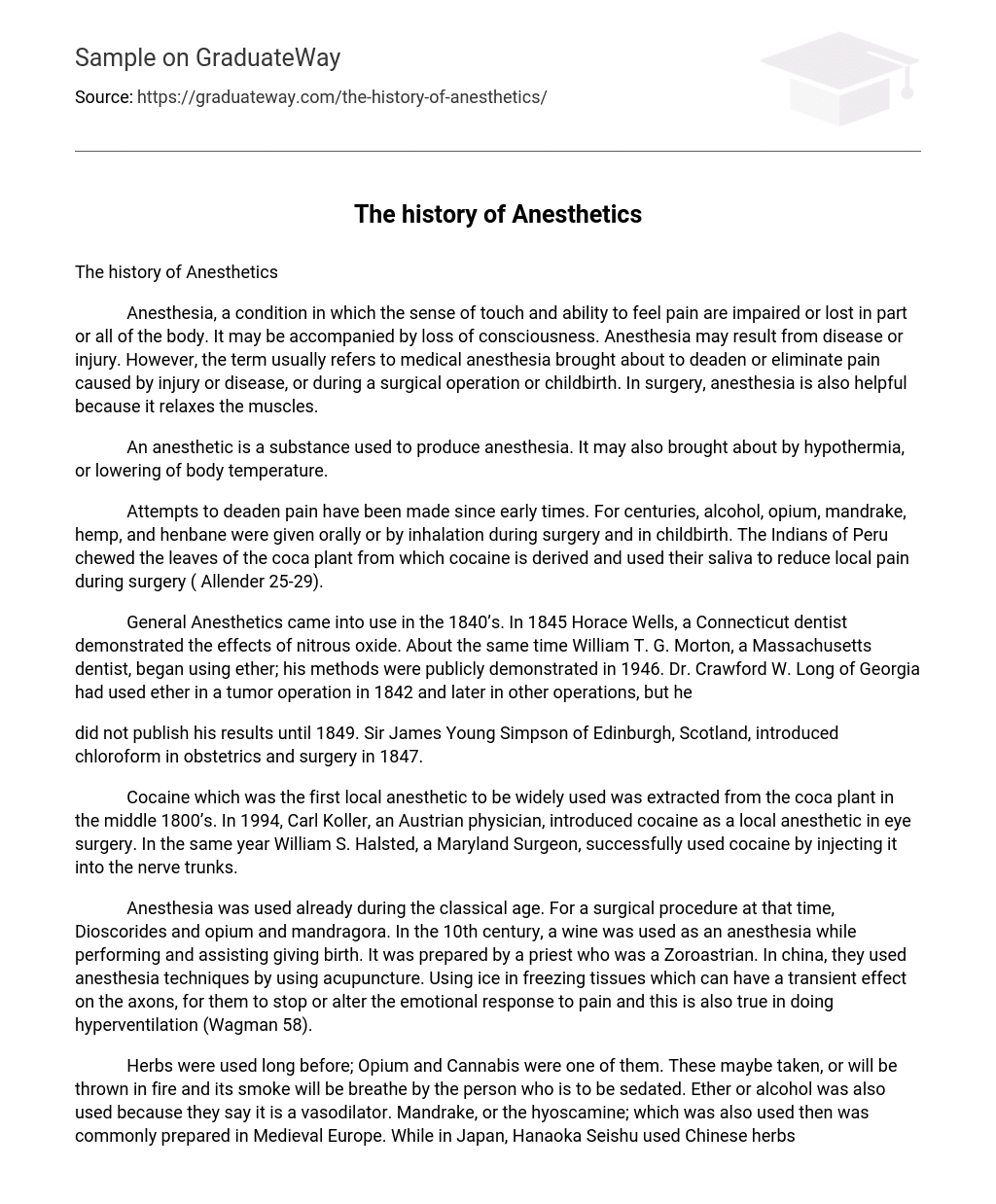Anesthesia, a condition in which the sense of touch and ability to feel pain are impaired or lost in part or all of the body. It may be accompanied by loss of consciousness. Anesthesia may result from disease or injury. However, the term usually refers to medical anesthesia brought about to deaden or eliminate pain caused by injury or disease, or during a surgical operation or childbirth. In surgery, anesthesia is also helpful because it relaxes the muscles.
An anesthetic is a substance used to produce anesthesia. It may also brought about by hypothermia, or lowering of body temperature.
Attempts to deaden pain have been made since early times. For centuries, alcohol, opium, mandrake, hemp, and henbane were given orally or by inhalation during surgery and in childbirth. The Indians of Peru chewed the leaves of the coca plant from which cocaine is derived and used their saliva to reduce local pain during surgery ( Allender 25-29).
General Anesthetics came into use in the 1840’s. In 1845 Horace Wells, a Connecticut dentist demonstrated the effects of nitrous oxide. About the same time William T. G. Morton, a Massachusetts dentist, began using ether; his methods were publicly demonstrated in 1946. Dr. Crawford W. Long of Georgia had used ether in a tumor operation in 1842 and later in other operations, but he
did not publish his results until 1849. Sir James Young Simpson of Edinburgh, Scotland, introduced chloroform in obstetrics and surgery in 1847.
Cocaine which was the first local anesthetic to be widely used was extracted from the coca plant in the middle 1800’s. In 1994, Carl Koller, an Austrian physician, introduced cocaine as a local anesthetic in eye surgery. In the same year William S. Halsted, a Maryland Surgeon, successfully used cocaine by injecting it into the nerve trunks.
Anesthesia was used already during the classical age. For a surgical procedure at that time, Dioscorides and opium and mandragora. In the 10th century, a wine was used as an anesthesia while performing and assisting giving birth. It was prepared by a priest who was a Zoroastrian. In china, they used anesthesia techniques by using acupuncture. Using ice in freezing tissues which can have a transient effect on the axons, for them to stop or alter the emotional response to pain and this is also true in doing hyperventilation (Wagman 58).
Herbs were used long before; Opium and Cannabis were one of them. These maybe taken, or will be thrown in fire and its smoke will be breathe by the person who is to be sedated. Ether or alcohol was also used because they say it is a vasodilator. Mandrake, or the hyoscamine; which was also used then was commonly prepared in Medieval Europe. While in Japan, Hanaoka Seishu used Chinese herbs when he performed an operation for breast cancer. He combined the herbs as know- how. What Seishu used was Tsusensan, from the Datura metel and Aconitum.
On October 16, 1846, Morton did an operation using ether. The Listerian Techniques developed during the 19th century and it was used as the means for having a surgery. Then in the 1820’s, Henry Hill discovered the usage of Carbon Dioxide. The properties of Carbon Dioxide that triggered its usage as an anesthesia was due to Humphry Davy. But the use of this gas is very limited for it is a laughing gas only. This was still used for tooth extraction by Wells. Horace. But then he realized he made a great error for the patient undergone a terrible pain (Claypool 33).Then another tooth extraction done on January 1942 used a different family of ether which is the diethyl ether. Dr. Long was the first to used anesthetics during an operation which is the excision of a cyst on March 1842. Dr. William Morton then showed to the society the usage of diethyl ether as an anesthesia by performing an excision of a tumor in the neck of the patient. After this event, Dr.’s Liston, Syme, Dieffenbach, Pirogoff had the chance of performing operation using ether (Brunner, Suddarith 78).
Many complaints are raised in the usage of ether, they say ether causes nausea and vomiting, it also has combustible properties. Some countries replaced the use of ether with chloroform. James Young Simpson, who discovered it in 1831 found out that chloroform, was very efficient as an anesthetic. Many countries then were influenced by the usage of chloroform. Bu then again, issues rose that chloroform is not safe when being administered not like the ether. These reason lead to many deaths because of using chloroform as an anesthetic agent (Claypool 47).
There are two main kinds of anesthesia. 1.) General and 2.) Local. It is customary to combine two or more anesthetics to lessen risks and to make the procedure more comfortable for the patient ( Brunner, Suddarith 65). Several kinds of general anesthetics may be administered at different stages during an operation, or a general and a local anesthetic may be used. Choice of anesthetic and method of administrating it depend on the purpose for which the anesthetic is to be used, and on the patient’s physical condition.
Reference:
Brunner, K., Suddarith, L. Medical- Surgical Nursing. J. G. Ferguson Publishing Company, 1993.
Wagman, R. J. The New Complete Medical & Health Encyclopedia. Little, Brown, 1985.
Allender, J. A., & Spradley, B. W. Community health nursing: Concepts and practice (5th Ed.). Philadelphia: Lippincott Williams and Wilkins, 2000.
Claypool, Jane. Anesthesia and Surgery. Watts, 1988.





